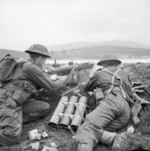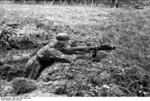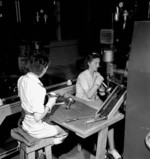PIAT Launcher
| Country of Origin | United Kingdom |
| Type | Launcher |
| Length | 990.000 mm |
| Weight | 15.000 kg |
| Ammunition Weight | 1.10 kg |
| Range | 115.000 m |
| Muzzle Velocity | 76 m/s |
Contributor: C. Peter Chen
ww2dbase"Projector, Infantry, Anti Tank", or PIAT for short, were anti-tank projectile weapons developed in response to the British Army's need for a more effective infantry anti-tank weapons than the existing Boys anti-tank rifles and the No. 68 AT Rifle Grenades. The design could be attributed to both Lieutenant Colonel Stewart Blacker of the British Royal Artillery and Major Millis Jefferis, although there were some disagreements in this matter. The production of PIAT launchers and shells began in late Aug 1942 by Imperial Chemical Industries Limited and other firms. They entered service in 1943. They fired shells spring in each launcher and a cartridge at the tail of each shell, with maximum direct fire range of 110 meters (115 yards) and maximum indirect fire range of 320 meters (350 yards). They were constructed of thin sheets of steel, and had very simple top-mounted aperture sights. Although designed for operation by a single soldier, each weapon was usually assigned to a team of two, with one person being the main operator while the other acted as the loader and ammunition carrier. They were first used in combat by Canadian troops during the Allied invasion of Sicily, Italy in mid-1943. Troops from the front reported that the coking and firing of the weapon was difficult and they were bulky, but they were nevertheless well liked; results from a 1944-1945 Canadian Army survey noted that these weapons were ranked first in terms of effectiveness for their designed purpose. Another study, conducted by the British, found that 7% of German tanks destroyed by British forces during the 1944 Normandy campaign were destroyed by PIAT launchers. From a manufacturing standpoint, their simple construction kept the costs low. In terms of usage outside of British and Commonwealth forces, between Oct 1941 and Mar 1946, the Soviet Union received 1,000 PIAT launchers and 100,000 rounds of ammunition. European resistance groups also received these weapons during WW2; a number of these weapons saw action during the 1944 Warsaw Uprising. Production ceased in 1950; between 1942 and 1950, 115,000 examples were built. After WW2, the British and Commonwealth troops used them during the Korean War, but shortly after they were replaced by the American bazooka-series of anti-tank weapons. In later conflicts, PIAT weapons were used by the Israeli Haganah against Arab armored vehicles during the 1948 Arab–Israeli War, and by both sides of the 1971 Indo-Pakistani War.Source: Wikipedia ww2dbase
Last Major Revision: Feb 2015
PIAT Launcher Mapa Interativo
Photographs
 |  |  |  |
PIAT Timeline
| 16 mai 1944 | British fusilier Frank Jefferson used a PIAT anti-tank launcher to destroy a German Panzer IV tank along the Gustav Line in Italy, which led to his unit repulsing a German counterattack which was spearheaded by the tank. He would later be awarded the Victoria Cross for this action. |
| 6 jun 1944 | British Company Sergeant-Major Stanley Hollis, using a PIAT launcher, took down several German pillboxes and a field gun during the Normandy invasion in France and was credited for saving the lives of many men. He was awarded the Victoria Cross, the only awarded for actions on the initial day of the invasion. |
| 12 jun 1944 | Ethnic Bhutia rifleman Ganju Lama of the British Indian Army, using a PIAT anti-tank launcher, knocked out two Japanese tanks under heavy machine gun fire at Ningthoukhong, Manipur, India. Despite a broken wrist and wounds to both hands, he engaged and killed the surviving Japanese tankers. He would be awarded the Victoria Cross for this action. |
| 21 out 1944 | After dark, on the Savio River in northeastern Italy, Canadian Army Seaforth Highlanders Private Ernest Alvia Smith used a PIAT anti-tank launcher to destroy a German Panther tank and two self-propelled guns and then used a Thompson submachine gun to kill or repel 30 German soldiers. He would later be awarded the Victoria Cross for this action. |
| 2 nov 1944 | British Army Royal Northumberland Fusiliers Captain (temporary Major) Robert Henry Cain was awarded the Victoria Cross for effectively using a PIAT anti-tank launcher against German tanks on multiple occasions between 19 and 25 Sep 1944 during the Battle of Arnhem in the Netherlands. |
| 9 dez 1944 | Whilst defending a position at Faenza, Italy, Lieutenant (temporary Captain) John Henry Cound Brunt, age 22, of the British Army Sherwood Foresters (attached Lincolnshire Regiment) used anti-tank PIATs, Bren guns, and a 2-inch mortar to drive back a German 90th Panzergrenadier Division counterattack. Later he turned another attack, blazing away with a Bren from the top of a Sherman tank. His conduct earned him the Victoria Cross but he did not live to know it. Supposedly safe by this time, he was killed on the following day by shellfire. |
Você gostou deste artigo ou achou este artigo útil? Se sim, considere nos apoiar no Patreon. Qualquer valor já vai ajudar! Obrigado. Por favor, ajude-nos a divulgar o site: Fique atualizado com WW2DB: |
Visitor Submitted Comments
3 Dec 2019 11:42:14 AM
Thank you Tom, the duplication and the typographical error have both been fixed.
All visitor submitted comments are opinions of those making the submissions and do not reflect views of WW2DB.

- » Wreck of Teruzuki Found (27 jul 2025)
- » USS Orlean's Bow Found (22 jul 2025)
- » The Emperor of Japan Planned to Honor WW2-era Japanese POWs in Mongolia (4 jul 2025)
- » US State Lawmaker John Winter Caught Using Racial Slur "Jap" and Apologized (11 jun 2025)
- » US Government Plans to Purge WW2 Information (17 mar 2025)
- » Ver todas as notícias
- » 1,181 biografias
- » 337 eventos
- » 45,111 entradas na linha do tempo
- » 1,246 navios
- » 350 modelos de aeronaves
- » 207 modelos de veículos
- » 376 modelos de armas
- » 123 documentos históricos
- » 261 instalações
- » 470 eventos
- » 28,473 fotos
- » 365 mapas
Winston Churchill, on the RAF
Por favor, considere nos apoiar no Patreon. Mesmo R$1 por mês já faz uma grande diferença. Obrigado!
Ou, por favor, nos apoie adquirindo alguns produtos do WW2DB na TeeSpring. Obrigado!
3 Dec 2019 11:25:10 AM
For 9 Dec 1944 you have the actions of British CPT John Brunt listed twice, and one of them misspells his name Blunt. FYI....